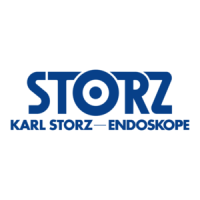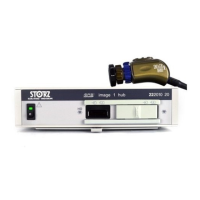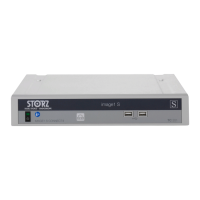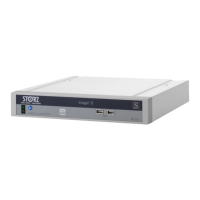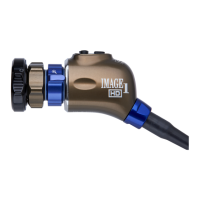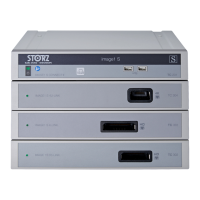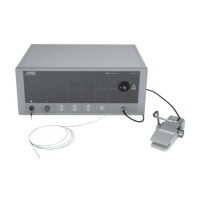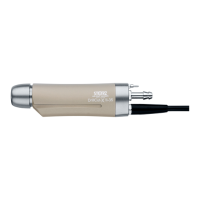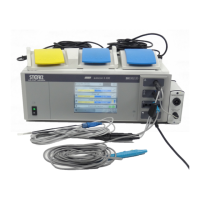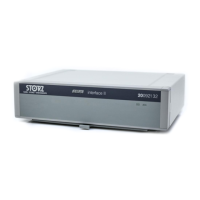Do you have a question about the Storz IMAGE1 S 4U and is the answer not in the manual?
Explains the meaning of Warning, Caution, and Note symbols used in the manual.
Provides general safety guidelines for using the equipment safely and effectively.
States that no direct contraindications are currently known for the medical device.
Specifies that only qualified physicians and medical assistants should use the camera head.
Details that the camera head operates at either 50 Hz or 60 Hz and must be selected locally.
Explains how to connect the endoscope and light cable to the camera head.
Describes how to adjust the focus using the focusing ring/knob on the camera lens.
Lists technical specifications for the IMAGE1 STM 4U camera head, including sensor, format, and dimensions.
Provides guidelines for storing and operating the camera head and CCU.
States compliance with IEC 60601-1 and IEC 60601-2-18 standards.
Mentions compliance with the Medical Device Directive (MDD) as Class I.
Provides instructions for the correct handling and care of the camera head to maximize its lifespan.
Presents a table summarizing reprocessing procedures for the camera head.
Lists general warnings regarding infection risk and proper reprocessing of medical devices.
Lists accessories required for carrying out reprocessing.
Details the preparation steps for cleaning and disinfecting the device.
Details the process of manual wipe-down disinfection for the exterior surfaces of the medical device.
Describes the manual precleaning procedure for the camera head.
Explains how to clean instrument surfaces with a brush under cold running water.
States that the device is not suitable for ultrasound treatment for technical reasons.
Outlines the procedure for completely immersing the medical device in a cleaning solution.
Details the process for completely immersing the medical device in a disinfectant solution.
Describes visual inspection of the cleaned and disinfected medical device for cleanliness and damage.
Specifies the use of standardized and approved packaging materials and systems.
Details various sterilization methods approved for the camera head.
Discusses limitations and procedures for STERRAD sterilization, including cosmetic changes.
Details V-PRO sterilization cycles and potential cosmetic changes to the camera head.
Explains the ethylene oxide sterilization procedure, including parameters and dismantling requirements.
Covers STERIS System 1E sterilization parameters and tray selection.
Provides warnings and recommendations for high-level disinfection.
Details the CIDEX disinfection procedure, including immersion times and rinsing.
Explains the Resert XL HLD disinfection procedure, including immersion times and rinsing.
Discusses factors determining the product's service life, including wear and reprocessing methods.
Provides instructions for the correct handling and care of the camera head to maximize its lifespan.
Presents a table summarizing reprocessing procedures for the camera head.
Lists general warnings regarding infection risk and proper reprocessing of medical devices.
Lists accessories required for carrying out reprocessing.
Details the requirements for utility water and critical water for instrument cleaning.
Explains the immediate steps for pre-cleaning the camera head after a procedure.
Provides detailed steps for manually cleaning the camera head using enzymatic solution.
Describes visual inspection of the cleaned medical device for cleanliness, damage, and dryness.
Specifies the use of standardized and approved packaging materials and systems.
Details various sterilization methods approved for the camera head.
Discusses STERRAD sterilization limitations and procedures.
Details V-PRO sterilization cycles and procedures.
Explains the ethylene oxide sterilization procedure, including parameters.
Covers STERIS System 1E sterilization procedures and tray selection.
Discusses factors determining the product's service life, including wear and reprocessing methods.
States that preventive maintenance is not essential but regular maintenance can enhance reliability.
Stipulates that only KARL STORZ authorized personnel should perform repairs.
Explains how to dispose of the unit as electronic scrap according to the WEEE directive.
Specifies that only manufacturer-authorized personnel can repair devices.
States that contaminated devices must not be shipped and must be decontaminated.
Outlines the conditions under which KARL STORZ is liable for the equipment's safety and performance.
Explains warranty conditions and the procedure for sending the device for service.
Lists compatible camera control units (CCUs) for the IMAGE1 STM 4U camera head.
Lists spare parts and recommended accessories for the camera head.
Discusses the suitability of the camera head for use near HF electro-surgical devices and potential interference.
Lists the main contact details for KARL STORZ SE & Co. KG in Tuttlingen, Germany.
| Category | Digital Camera |
|---|---|
| Resolution | 4K UHD |
| Sensor Type | CMOS |
| Focus | Automatic / Manual |
| White Balance | Automatic / Manual |
| Exposure Control | Automatic / Manual |
| Video Output | DVI |
| Dimensions | Dependent on configuration |
| Weight | Dependent on configuration |
